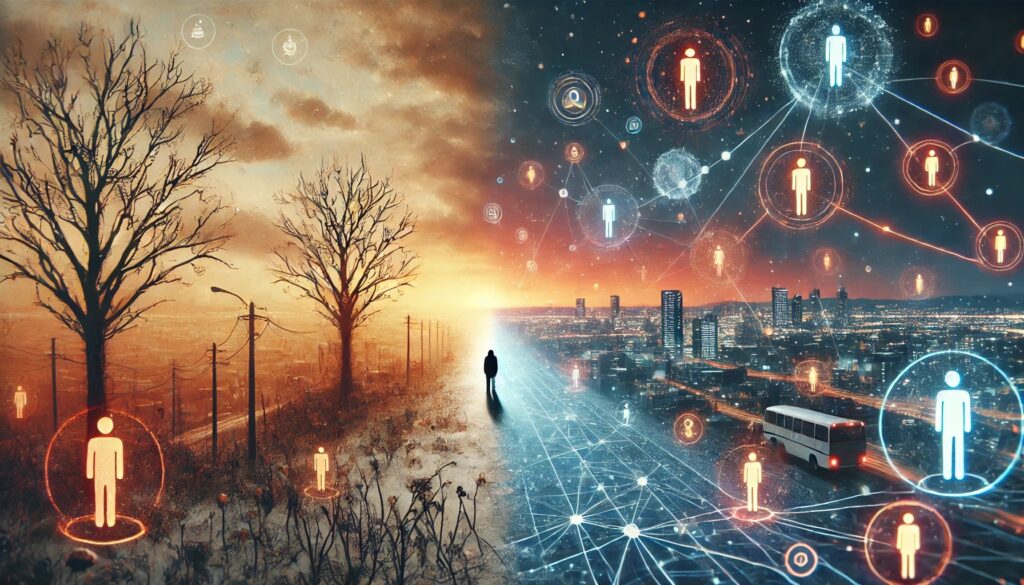
ChatGPT:
Why Is the Loneliness Epidemic So Hard to Cure?
Loneliness, particularly in the context of the COVID-19 pandemic, has become an increasingly prominent and complex issue, challenging traditional approaches to social connection and public health. This article explores why the loneliness epidemic has been so difficult to address, examining the underlying causes that are deeply rooted in societal changes, the psychological and physiological impacts of loneliness, and the inadequacies of conventional solutions. It argues that to effectively tackle loneliness, we must rethink not only the problem but also the ways we connect with others in a rapidly changing world.
🦠 The Rise of Loneliness During the Pandemic
In 2020, as the COVID-19 pandemic forced people into isolation, the issue of loneliness became more visible and urgent. Richard Weissbourd, a psychologist and Harvard lecturer, observed this rising tide of loneliness and decided to study it more closely. He launched a comprehensive survey to understand the extent and nature of loneliness in the U.S. His survey revealed startling levels of chronic loneliness, particularly among young adults aged 18 to 25, many of whom reported feeling more isolated due to the pandemic. This isolation was not just about being physically apart from others but about a deeper sense of disconnection and lack of meaning in life.
🧠 The Complex Nature of Loneliness
Loneliness is a multifaceted and deeply subjective emotion. Unlike isolation, which is simply the state of being alone, loneliness is about the gap between the social connections one desires and those one actually has. This discrepancy can manifest in crowded places or even within relationships, where one might still feel profoundly lonely. The complexity of loneliness makes it challenging to study and address because it is not just about increasing social interaction but about understanding and bridging this emotional gap.
📊 Weissbourd’s Study and Its Findings
Weissbourd’s survey, conducted through the Making Caring Common project at Harvard, involved a 66-question survey sent to nearly 1,000 people across the U.S. The results were revealing: 36% of respondents reported feeling chronic loneliness in the previous month, while another 37% experienced occasional loneliness. Among the lonely, a significant portion felt that they were more likely to reach out to others than others were to them, and many felt that no one outside their family genuinely cared about them. The study highlighted how loneliness often stems from a perceived lack of reciprocal care and meaningful connection.
🌍 The Global Context of Loneliness
The issue of loneliness is not confined to the United States. Other countries like Japan and Britain have also recognized the problem and have even appointed ministers of loneliness to address it. These efforts, while well-intentioned, often focus on restoring past forms of social connection, such as community gatherings or neighborhood checks. However, the article suggests that such approaches may be insufficient because they fail to address the root causes of loneliness in the modern world, which include broader societal shifts like the breakdown of traditional communities and the rise of digital communication.
💔 The Health Impacts of Loneliness
Loneliness is not just a social or emotional issue; it has significant health implications. Research by psychologists like Louise Hawkley and John Cacioppo has shown that loneliness can lead to increased blood pressure, cognitive decline, and a higher risk of diseases like Type 2 diabetes and cardiovascular issues. The physiological toll of loneliness underscores the urgency of addressing this epidemic, as it can have severe consequences on both individual well-being and public health.
🌀 The Feedback Loop of Loneliness
One of the most insidious aspects of loneliness is how it can perpetuate itself. When people feel lonely, they often withdraw further, convinced that they are unworthy of social interaction. This creates a vicious cycle where the fear of rejection or failure in social situations reinforces their isolation. Psychological studies have shown that this feedback loop can be difficult to break, as loneliness impacts not just emotions but also physiological responses, making it harder for lonely individuals to engage in social activities that might alleviate their loneliness.
📉 The Decline of Traditional Social Structures
Over the past several decades, there has been a marked decline in the traditional social structures that once provided a sense of community and belonging. Institutions like churches, unions, and neighborhood associations have seen decreased participation, leaving many without strong social ties. This trend has been exacerbated by changes in family structure, with fewer people getting married or living in multi-person households. As these traditional forms of community have weakened, many have turned to digital spaces for connection, but these often lack the depth and reciprocity needed to combat loneliness effectively.
📱 The Double-Edged Sword of Digital Communication
While technology and digital communication are often blamed for increasing loneliness, they also offer new forms of connection that can be meaningful, especially for marginalized or geographically dispersed individuals. For example, online communities can provide support and a sense of belonging for people with rare diseases or for LGBTQ+ youth who may feel isolated in their local environments. However, the article notes that digital communication cannot fully replace the need for physical presence and deep emotional connections, which are crucial for combating loneliness.
🔄 Adapting to a New Social Reality
The article suggests that the solution to the loneliness epidemic lies not in trying to return to an idealized past but in adapting to new realities. As society evolves, so too must our approaches to connection and community building. This may involve embracing new forms of togetherness facilitated by technology, while also finding ways to create meaningful, reciprocal relationships in a world where traditional social structures have eroded. The path forward may be challenging, but it is essential for addressing the deep-seated loneliness that affects so many today.
🌱 Moving Forward: A New Era of Connection
Ultimately, the article argues that the loneliness epidemic is a reflection of broader societal changes that have disrupted traditional forms of connection. While these changes have created challenges, they also offer opportunities for new forms of community and togetherness. By rethinking our approaches to social connection and embracing the possibilities of both physical and digital interaction, we can begin to address the loneliness epidemic in a meaningful way. The future of connection may look different from the past, but with thoughtful adaptation, it can still be rich, fulfilling, and capable of meeting the deep human need for belonging.
Sections in the Expanded Summary:
- 🦠 The Rise of Loneliness During the Pandemic
Explores how the COVID-19 pandemic highlighted and exacerbated existing issues of loneliness, particularly among young adults. - 🧠 The Complex Nature of Loneliness
Discusses the subjective and multifaceted nature of loneliness, distinguishing it from mere social isolation. - 📊 Weissbourd’s Study and Its Findings
Summarizes the key findings from Richard Weissbourd’s survey on loneliness, including the prevalence of chronic loneliness. - 🌍 The Global Context of Loneliness
Examines how other countries like Japan and Britain are also grappling with the loneliness epidemic and their approaches to addressing it. - 💔 The Health Impacts of Loneliness
Highlights the significant physiological and health effects of loneliness, drawing on research by Louise Hawkley and John Cacioppo. - 🌀 The Feedback Loop of Loneliness
Explains how loneliness can create a self-perpetuating cycle, making it difficult for individuals to break free from their isolation. - 📉 The Decline of Traditional Social Structures
Looks at the decline in participation in traditional social institutions and how this has contributed to increased loneliness. - 📱 The Double-Edged Sword of Digital Communication
Considers the role of technology in both exacerbating and alleviating loneliness, particularly in creating new forms of connection. - 🔄 Adapting to a New Social Reality
Argues that the solution to loneliness lies in adapting to new social realities rather than trying to return to past forms of connection. - 🌱 Moving Forward: A New Era of Connection
Suggests that by rethinking our approaches to social connection, we can create a future where meaningful relationships are still possible.
Q&A on the Loneliness Epidemic
Q: What is the key difference between loneliness and isolation?
A: Loneliness is a subjective feeling of being disconnected, even when surrounded by people, whereas isolation refers to being physically separated from others. Loneliness stems from the gap between desired and actual social connections.
Q: How did the COVID-19 pandemic affect loneliness?
A: The pandemic exacerbated loneliness by increasing physical isolation and disrupting traditional social connections. Many, especially young adults, reported heightened feelings of loneliness due to the lack of meaningful interaction and purpose.
Q: What were the main findings of Richard Weissbourd’s study on loneliness?
A: Weissbourd’s study revealed that 36% of respondents experienced chronic loneliness, and another 37% experienced occasional loneliness. It highlighted that many lonely people feel they initiate more social interactions than others and often feel uncared for outside their family.
Q: How does loneliness impact physical health?
A: Loneliness has been linked to serious health issues, including increased blood pressure, cognitive decline, and higher risks of diseases like Type 2 diabetes and cardiovascular problems. It can also lead to shortened life spans.
Q: What is the “feedback loop” of loneliness?
A: The feedback loop of loneliness refers to the cycle where loneliness causes individuals to withdraw further from social interactions, driven by fear and anxiety, which in turn deepens their loneliness.
Q: How have societal changes contributed to the rise in loneliness?
A: The decline of traditional social institutions like churches and neighborhood groups, along with changes in family structure and increased digital communication, have weakened social ties and contributed to rising loneliness.
Q: Can technology help combat loneliness?
A: Yes, while technology is often blamed for increasing loneliness, it can also facilitate meaningful connections, especially for those who are marginalized or geographically isolated. However, it cannot fully replace the need for physical and emotional connections.
Q: What are some modern approaches to addressing loneliness?
A: Modern approaches suggest adapting to new realities by embracing both digital and physical connections, rather than trying to return to outdated forms of community. This might include creating new social norms and spaces for connection in the digital age.
Q: Why is loneliness considered a public health issue?
A: Loneliness is seen as a public health issue because of its widespread prevalence and its significant impact on both mental and physical health. It is linked to higher risks of chronic diseases and mental health disorders, making it a priority for public health interventions.
Q: What role do governments and organizations play in addressing loneliness?
A: Governments and organizations can help by raising awareness, creating supportive communities, and implementing policies that foster social connections. Examples include appointing ministers of loneliness and encouraging community-based initiatives.

